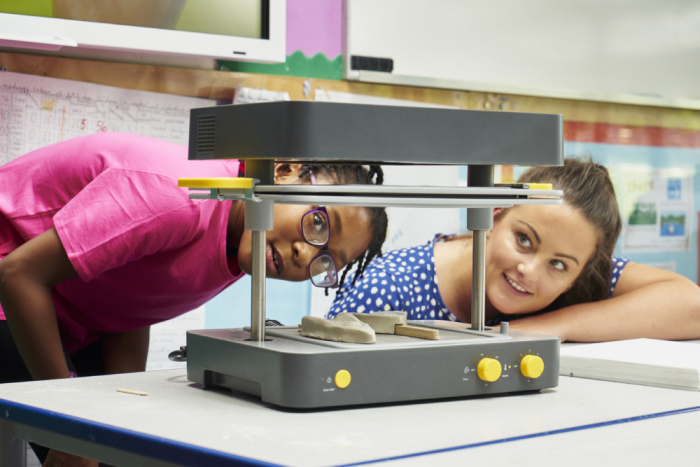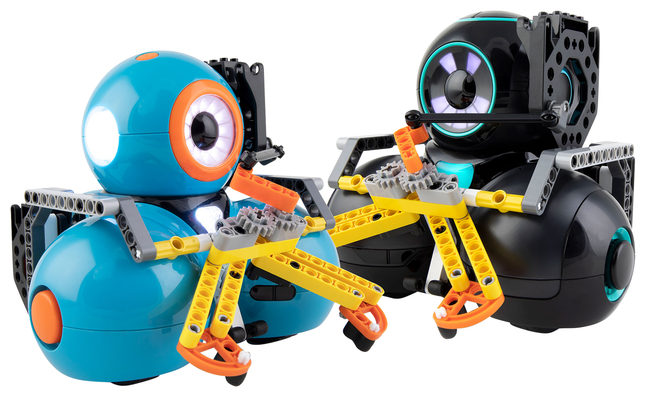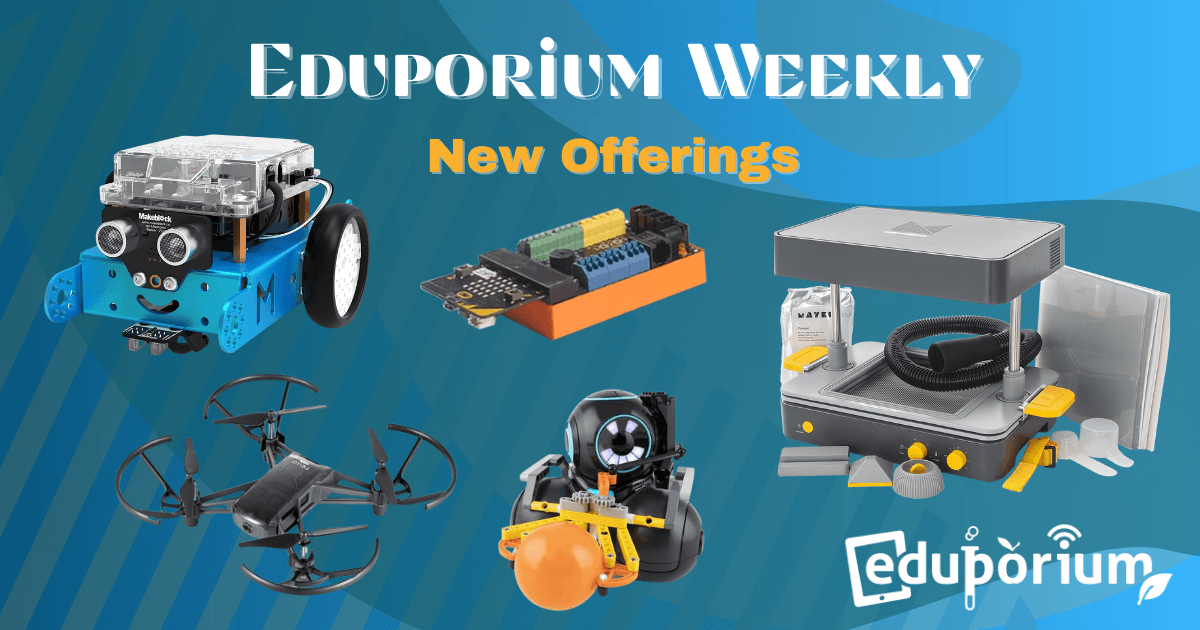Our online store is always growing and we like to think of it as a one-stop shop for all educational technology needs. Whether it’s early education or high school technology, we regularly add the latest releases or versions of existing EdTech from a lot of the world’s top vendors. We also offer an Educator Discount of up to 20 percent on a lot of these items and can provide teachers and tech leaders with an easy, quick, and efficient purchasing experience. So, what’s recently been added the Eduporium store? We’ll get into that and more, including how to use these EdTech tools in the classroom, in the latest edition of the Eduporium Weekly! Keep reading to learn more about what you can find in the ‘New Arrivals’ section of our store.
DJI Tello EDU Drone
DJI is one of the world’s leaders in powerful drones, including some of the programmable variety. We have had some of their best models on our store for a while now, including the MAVIC, MAVIC 2, SPARK, and more. They recently released the Tello EDU drone, which is designed specifically for use in education and offers educators a very affordable option. The single drones start at just $129 each and classroom packs are also available in small, medium, and large sizes. Getting started with Tello EDU is pretty easy as students simply have to place the included battery into the drone and turn it on. The best part about the Tello EDU, as we mentioned, is that it is programmable. This means that students are able to learn about how to actually pilot the drone and, perhaps more importantly, how to code in a few different languages. With this code, they can create programs that then completely determine the drone’s flight path and introduce them to the power of programming on a whole new level!
The Tello EDU drone can be controlled using the Tello or Tello EDU apps on a compatible device. Using the app, students can create programs in one of three languages: Python, Scratch, or Swift. The great thing about the apps is that they support both beginner and advanced programming and the variety of available languages speaks to that. The beginner programming with Scratch is block based and gives students drag-and-drop control of the programs they construct. They can also code in Swift and explore some pre-made challenges that guide them through coding and flying. In terms of advanced programming, students can also access Python within the Tello EDU app and take part in Mission Pads to increase the precision of their programs. Using Mission Pads, students can control the drone’s aerial acrobatics more precisely and, of course, gain greater exposure to more complex programming.
With the single unit Tello EDU drone, you get the drone, a battery, a micro USB cable, eight propellors, four propellor guards, four mission pads, and a propellor removal tool. The Small Classroom Kit comes with five times as much equipment (five drones, 40 propellors, 20 propellor guards, etc.), the Medium Classroom Kit comes with 10 times as much equipment, and the Large Classroom Kit comes with 20 times as much equipment! Tello also comes equipped with DJI’s electronic image stabilization technology, ensuring that images and videos recorded from the air always come out crystal clear. On top of that, students can program multiple drones to fly together in a swarm, adding a new wrinkle to STEM learning with drones. The Tello EDU drone is legitimately a top flight option (pun intended) for teaching students about drone piloting, safety, and potential future careers at a very affordable price. And, the fact that they can also learn programming in one of three amazing languages makes it that much better. Head to our store to browse the options and get one of your own!
Hummingbird Bit
There’s a new way to program with the Hummingbird Robot, adding more opportunities for innovation and excitement to the kits we’ve always offered. Teachers have had access to the Hummingbird Duo Kits from our store for a couple of years now. These kits came with the Hummingbird Duo Controller, which is an Arduino-based board that is designed specifically for use with Hummingbird. They can use this board as a controller for programming, customizing, and controlling any robot they build with the Hummingbird Kit. Now, there’s a new way to program with Hummingbird and that’s the Hummingbird Bit! Using a Hummingbird Kit and a micro:bit board, students can create programs in many different languages, including BirdBlox, MakeCode, Snap!, Python, and Java. Programming with the Bit is also supported on many different devices, including Windows, Macs, Chrome, iOS, Android, and Linux, giving educators a number of options for integrating this powerful and affordable technology in the classroom.
There are four different Hummingbird Bit kits: The Base Kit, Premium Kit, Classroom Bundle with a micro:bit and cable, and Classroom Bundle without the micro:bit and cable for those who already have micro:bit’s in the classroom. The Base Kit is designed for use by anywhere between one and four students at a time and enables students to turn anything into a robot using various craft materials, lights, and sensors. The Hummingbird Bit Premium Kit includes many of the same components, but also comes with some additional pieces, like LEGO adapters, a sound sensor, and a rotary sensor. Using either of these kits, educators can integrate robotics into the teaching of any subject and give their students the opportunity to enhance their creativity using many different materials. Plus, they’re both reusable and have been known to inspire those students who are not necessarily interested in technology.
As for the Classroom Bundles, there are two basic options educators could choose from: One with micro:bit’s included and one without micro:bit’s included. Both of these options are then broken down into kits of different sizes—small, medium, and large. The Small Classroom Bundles include four Premium Kits and four micro:bit’s, the Medium Classroom Bundles include eight Premium Kits and eight micro:bit’s, and the Large Classroom Kits include 12 Premium Kits and 12 micro:bit’s. The Small Kits can accommodate 8-12 students, the Medium Kits can accommodate 12-24 students, and the Large Kits can accommodate 24-36 students. Hummingbird and the Hummingbird Bit are fantastic for students to use as early as fourth grade and they can continue programming with them up through high school! To check out all the Hummingbird Duo and Bit options on our store, head on over!

Mayku FormBox
We’ve been invested in the 3D printing in education scene for a few years now and, while the Mayku FormBox isn’t exactly a 3D printer, it does offer students a similar experience in the classroom. Mayku is a desktop vacuum former that allows students to use technology to create and remix three-dimensional objects quickly and safely. Now available for purchase on our store, the FormBox can be used to make molds in just seconds and truly empower students to turn the creative ideas in their heads into reality. With the FormBox, students can learn about vacuum forming, product design, and different manufacturing methods as they invent in an all-new way. Whether it’s in a classroom, library, makerspace, or innovation lab, the Mayku FormBox is an affordable addition that innovative educators will definitely have to consider adding to their technology offerings!
The FormBox is a MakerEd option that’s safe, fast, and affordable. The coolest thing about this former, however, is the number of different materials students can use to invent with it. Whereas traditional 3D printers allow them to use one or two kinds of filaments and maybe a handful of specialized materials if they want to try something different, the FormBox is designed to allow for inventing with many different materials. These include resin, concrete, plaster, jello, ice, foam, silicone, soap, and even chocolate! Chocolate is definitely a new one, but we’re very eager to see how this works in the near future. Also, by all accounts, setting up the FormBox is pretty easy. The machine comes intact right out of the box and students or teachers would only need to attach the power cable and a vacuum hose to the machine. Just about any hose from any run-of-the-mill, household vacuum should do the trick. The FormBox also comes with a vacuum hose, so the attachment process should be pretty straightforward!
The FormBox comes with the former machine (including a power supply and vacuum connection tube), multiple instructional guides (there are also videos available online), three starter templates, 15 cast sheets, 15 form sheets, Mayku Pour, a 2-year manufacturer warranty, and more. The cast and form sheets can also be purchased separately in addition to what comes in the box. To get started, users can place in a casting sheet, clamp the machine down, and set the timer for the appropriate amount of time. They can then put the model in the middle of the print bed and drop the levers down so that the sheet covers the object. Students can let it cool and they’ll have their own 3D formed object pretty quickly! Raising and lowering the levers is pretty easy to do and the FormBox is definitely a unique tool for education. It’s also appealing that it’s at a pretty low price point and the fact that students can use a bunch of different (and very unique) materials to form their own objects is certainly a plus!
mBot-S
As is often the case, the brands you see on our always-growing store tend to expand fairly often. One of the names that we’ve featured the longest is the mBot, which has had multiple versions already, but now has its latest offering. We’ve offered the 2.4G mBot in the past as well as the Bluetooth mBot, but their newest model is now here! The mBot-S is the latest take on the mBot and it still offers a smooth, entry-level experience for any student interested in robotics! Designed for students aged 8 and up, the mBot-S includes a number of upgrades from the previous Makeblock robots, including, most notably, an on-board LED matrix that students can use to display customized images by programming its LEDs! Whether you’re teaching in an elementary or middle school classroom, the mBot-S is a dynamic coding tool that can be used to engage kids from start to finish and help them zero in on key coding concepts as they go!
Like other mBot models, students are able to assemble the mBot-S themselves. It comes with all the parts they need, including the tools and guides to help them get it put together in less than 30 minutes. Once they have it built, students can access the mBlock 5 programming environment on either a tablet or desktop computer, which they can use to create programs that control the robot’s movements or simply play some engaging games. The software is block-based and very much visual, giving all those who use it a great experience as they code. After students create their programs using the software, they can see the mBot-S execute them in the real, physical world and even use elements like sound, light, and movement to compel their bot to respond! The mBot-S can be programmed to avoid obstacles, follow lines, and even be controlled using a compatible remote.
The mBot-S is compatible with mBlock 5, mBlock 3, and the Makeblock app. Students can access mBlock 5 on either a PC or mobile device, while the Makeblock app can only be accessed on mobile devices and mBlock 3 can only be accessed on PC’s. Also, mBot-S is compatible with most of Makeblock’s add-ons, including the Six-legged Robot, Servo Package, Light and Sound Kit, and more, which are all also available on our store. The mBot-S even comes with the initial four batteries it needs to operate as well as a screwdriver, USB cable, and the screws for assembly. As they build the robot, students will learn about both robotics machinery and electronics parts before having the opportunity to develop logic and design thinking skills once they begin programming.

Gripper Building Kit
Wonder Workshop is among the very best EdTech brands out there as their Dash, Dot, and Cue robots have given tons of students exciting STEM learning opportunities. Using these robots on their own (or the Dash and Dot together) helps students learn vital 21st century skills—most notably coding—and also problem solving, collaboration, and creativity. They also have a bunch of accessories that can be used with these robots, but their newest one is probably the coolest one yet. They recently revealed the Gripper Building Kit for use with the Dash and Cue! This kit is easy to construct and allows students to engineer a set of functioning arms that they can attach to either the Dash or Cue. Using the structures they build, they can greatly expand the capabilities of their robots and get more opportunities to include new actions and events in the programs they create!
The kit comes with the gears, levers, and axles students need to build the arms for grabbing, holding, and launching objects. As they build them and connect them to their robot, they’re getting some more beneficial exposure to engineering and tinkering albeit on a lower level. Once these structures are secured to the bot, then kids can create new functions in their programs as they code with one of the Wonder Workshop apps. Students have access to functions that tell the gripper arms to do things like lift, carry, pull, pick up, and place objects however they would like. As long as the object is light enough for the gripper to pick up, they can easily move it from one place to another! The Gripper Kit is designed for use by students in Grades 3-5 and makes for an exciting addition to learning with the Dash or Cue in the classroom or, since there’s a lot of building involved, it could be used in makerspaces, too!
If you already have a Dash or Cue Robot (the gripper is not compatible with Dot), adding this accessory to the fold is a fun way to increase their capabilities. The Gripper Building Kit comes with a 76-piece construction set, three building brick connectors, one plastic ball for launching, one foam rubber cube, an instruction booklet, and activity guides for using the Gripper with both the Dash and Cue. Educators can also get reduced pricing on the Gripper Kit when creating an Educator Discount account on the Eduporium site. Basically, it’s an affordable way for teachers to add new wrinkles to STEM education and keep their students engaged! To order a Gripper Building Kit or any other Wonder Workshop items, check out our store. Also, be sure to monitor our store since we are always adding new technology for educators to explore, acquire, and use to bolster 21st century teaching!
For the latest EdTech, STEM, and 21st century education news, follow us on Twitter and Instagram. Like us on Facebook, too, or sign up for our newsletter for our latest product announcements and offerings. If you have an idea for an Eduporium Weekly theme, send us a message on social media or comment below.



